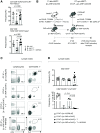Sphingosine-1-phosphate Receptor-1 Agonist Averts the De Novo Generation of Autoreactive T-cells in Murine Acute Graft-versus-Host Disease
- PMID: 34263142
- PMCID: PMC8274799
- DOI: 10.1097/HS9.0000000000000613
Sphingosine-1-phosphate Receptor-1 Agonist Averts the De Novo Generation of Autoreactive T-cells in Murine Acute Graft-versus-Host Disease
Figures


Similar articles
-
Immunosuppressive activity of FTY720, sphingosine 1-phosphate receptor agonist: II. Effect of FTY720 and FTY720-phosphate on host-versus-graft and graft-versus-host reaction in mice.Transplant Proc. 2005 Jan-Feb;37(1):107-9. doi: 10.1016/j.transproceed.2004.12.287. Transplant Proc. 2005. PMID: 15808562 No abstract available.
-
Sphingosine 1-Phosphate Signaling and Its Pharmacological Modulation in Allogeneic Hematopoietic Stem Cell Transplantation.Int J Mol Sci. 2017 Sep 21;18(10):2027. doi: 10.3390/ijms18102027. Int J Mol Sci. 2017. PMID: 28934113 Free PMC article. Review.
-
S1PR5 regulates NK cell responses in preventing graft-versus-host disease while preserving graft-versus-tumour activity in a murine allogeneic haematopoietic stem cell transplantation model.Hematol Oncol. 2020 Feb;38(1):89-102. doi: 10.1002/hon.2669. Epub 2019 Nov 26. Hematol Oncol. 2020. PMID: 31465552
-
Altered T-cell entry and egress in the absence of Coronin 1A attenuates murine acute graft versus host disease.Eur J Immunol. 2014 Jun;44(6):1662-71. doi: 10.1002/eji.201344155. Eur J Immunol. 2014. PMID: 24752751 Free PMC article.
-
Sphingosine 1-phosphate (S1P): Physiology and the effects of S1P receptor modulation.Neurology. 2011 Feb 22;76(8 Suppl 3):S3-8. doi: 10.1212/WNL.0b013e31820d5ec1. Neurology. 2011. PMID: 21339489 Review.
Cited by
-
Graft-Versus-Host Disease Mouse Models: A Clinical-Translational Perspective.Methods Mol Biol. 2025;2907:1-56. doi: 10.1007/978-1-0716-4430-0_1. Methods Mol Biol. 2025. PMID: 40100591 Review.
References
-
- Zeiser R, Blazar BR. Acute graft-versus-host disease. N Engl J Med. 2018; 378:585–586. - PubMed
LinkOut - more resources
Full Text Sources
